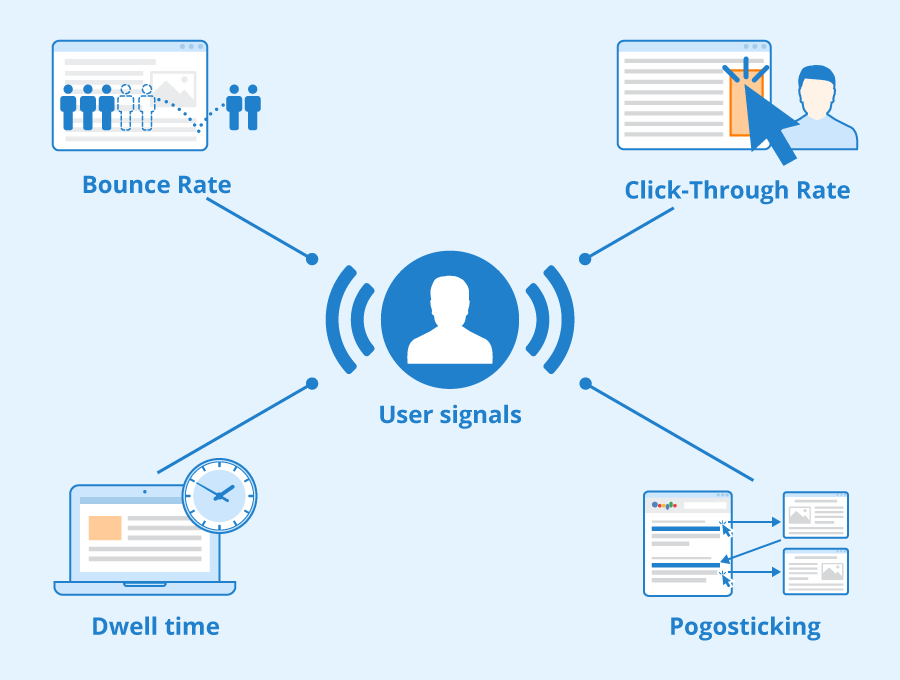
The only place heavy traffic is appreciated and desired is on your website, hands down!
And don’t even get me started on the lengths one needs to go to get more traffic.
But how do you measure traffic?
The first and foremost thing to consider to measure and improve your campaign to increase traffic is the Click-through rate.
Read on to know the importance of CTR in SEO.
What is CTR in SEO?
Click-through rate (CTR) is the percentage of people who clicked on a link out of the number of people who viewed the link.
That is to say if 10 people came across the link to your website, and 2 people ended up clicking on the link, then the click-through rate is 20%.
CTR is the quality score of your ads, listings, YouTube videos, and keywords. Quality in this case refers to the relevance of your ads and other links to user queries.
How do you calculate CTR?
Click-through rate = (Number of clicks / Number of impressions) x 100
CTR is a popular SEO metric that tells you whether searchers are finding your ads relevant or not. A high CTR means users are finding your ads highly relevant and a low CTR indicates that users are not finding your ads relevant enough.
What are the benefits of CTR?
The Click-through rate is quite an important metric in the digital marketing field.
If your content is out there on an online platform, whether written text, images, or videos, several people may bump into it, and some of them are going to click open to see what it is all about.
CTR tells you whether your ad copy is working, whether your title and metadata are bait-y enough for clicks, and whether your email subject lines are forcing users to open them.
Pay-per-click Marketing
Search engines deem CTR as a very important factor for revenue. Pay-per-click marketing or search engine marketing is a form of advertising online so that your website/business appears at the top of organic search results.
You are basically paying the search engine to stay at the top of search results for specific user queries. Each click earned in those results is paid for.
Paid Ads
When users search for queries in search engines, they are exactly telling what they are looking for. As a good advertiser, your job is to provide the exact response to their queries in your paid ads.
You will want to know which words attract clicks. The CTR of different keywords helps you measure the performance of ads in searches and you can increase relevancy accordingly.
Email marketing
You use CTR to measure the number of people who clicked on the link in your email from the total number of people who opened it.
Social media marketing
It is the same general rule here too. CTR determines the number of people who viewed your ad on social media against the number of people who actually clicked on the Ad.
Internal links on websites
Other than advertisements, CTR also measures the performance of internal links on websites, elements of Call-to-action, etc.
SEO
SEO is not just about ranking in the Search Results Pages(SERPs), but also getting organic traffic to your website through relevant content to user queries.
You can use CTR to know how many people visited your pages out of the total number of people who landed on the SERP. This shows whether users are finding your content relevant or not.
CTR determines the performance of your pages that are ranking in the Search Results Pages(SERPs).
CTR & SEO: Is CTR a ranking signal?
Google has maintained for ages that it does not consider CTR as a ranking signal. Here is a tweet by Google’s John Mueller:
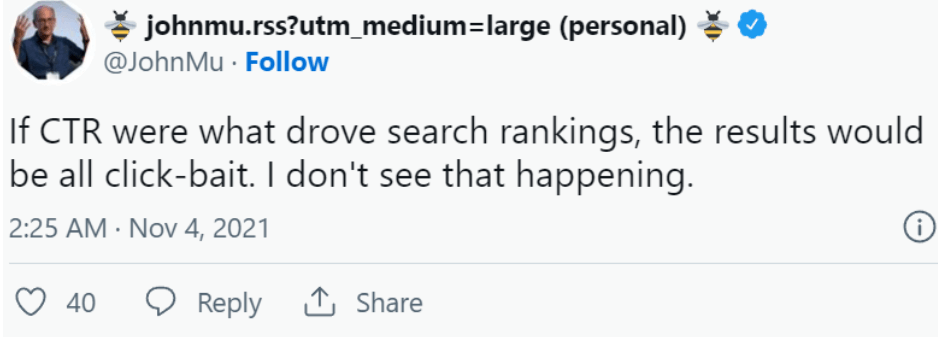
Let us set that aside for a bit and think logically.
Traffic matters for SEO. So CTR is a part of SEO.
If you are already ranking in the SERP, CTR depends on what position you are ranking. The ones that ranker is usually the ones with the higher click-through rate.
But if a link is ranking low, will a dramatic increase in CTR make Google push it up to the top of the results?
Apparently, it can get Google’s attention. Let’s see what the master Rand Fishkin, founder of Moz, said about the impact of clicks and click-through rate on ranking. He gives the example of “How to make perfect sushi rice”
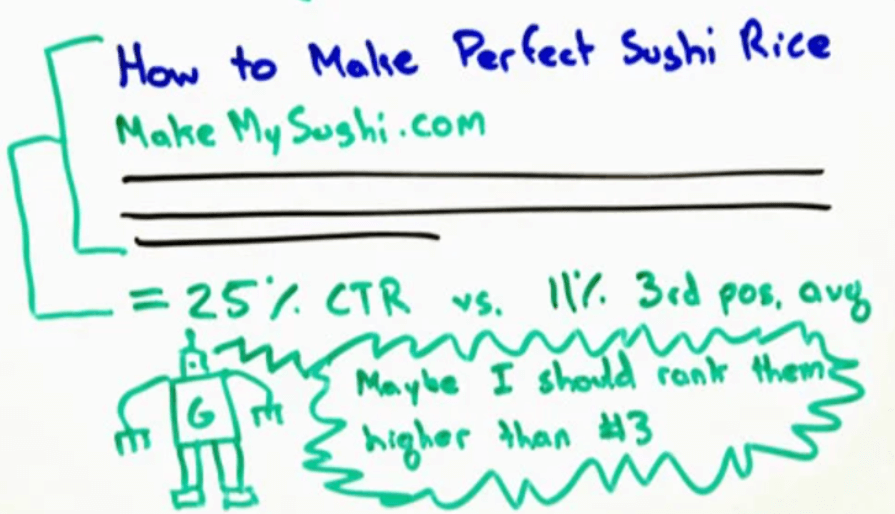
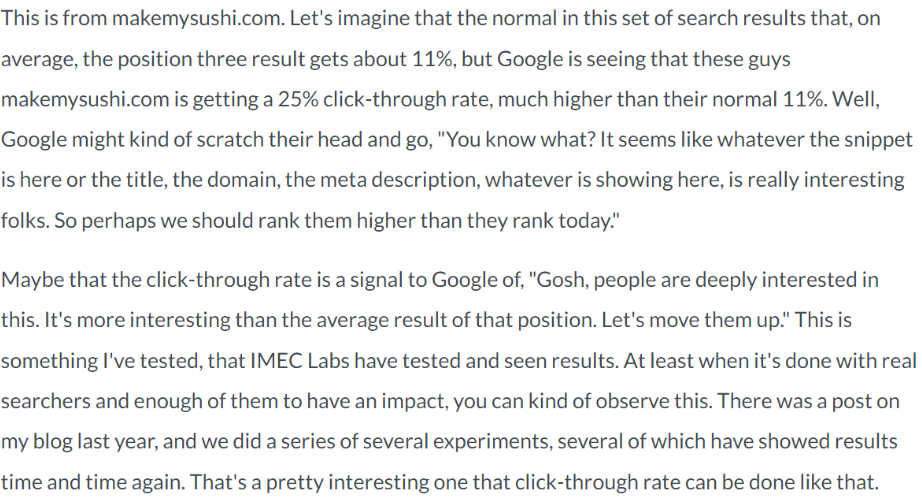
On one hand, there is some logical explanation for CTR as a ranking factor, while on the other, we have Google itself denying it. So what should we do?
Let’s not get into the debate at all.
Should you continue to track CTR?
Yes!
Ranking signal or not, it is a metric that tells you how your content is performing. So don’t rule it out. But don’t place all your bets on one stock. There are plenty of metrics influencing your SEO. Make use of them too.
How to improve Organic CTR?
The organic Click-through rate is the percentage of people that click on a result in the SERP, out of the people who saw it.
What is a good CTR in SEO?
Like most things in SEO, the answer to that question is – “It depends.”
What does it depend on?
- Search intent
- The niche/industry
- The keywords you have chosen
- Branded keywords/unbranded keywords
- Individual ad campaigns
- SERP Snippets
- Google News results
- Ranking position
- And more…
With different variables involved and thanks to the ever-changing Google algorithm, it is difficult to get specific methods to improve CTR. But here are some simple practices you can follow without spending the big bucks.
Best practices for CTR
Rethink your target audience
A well-defined target audience is a must. If your CTR is bad, it could mean you are targeting the wrong audience. If you are targeting gender or age, try to get more specific about the user persona.
You can define the user persona by considering their background, education, demographic information, socio-economic conditions, buying habits, etc. When you get specific, you have a better chance of hitting a home run.
Optimize the title
If you are using Rank Math Pro, on-page SEO is going to be a piece of cake. Since the title is the first thing a reader is going to see you need to work hard on it.
You can take the help of headline generators for the same but don’t forget to use your own logic and common sense.
Given that there is no right or wrong here, you can only try and see what works for you.
You can follow some of these tips to optimize your title.
Use brackets in the title
It is a way of adding specific details to your headline so users already know what the content is about. They are more likely to click when they are informed about what they can expect.
Example – The Most Definitive Ahrefs Review [+5 Unique ways to use it]
Add numbers
Readers can predict how much content they are going to get. They are mentally prepared automatically. If it is a statistic it could impress the user into clicking on it
Example –
7 Best Books on Writing that will inspire you to Write
How I ranked for 2400 keywords with Zero Backlinks
Use emotions
People relate to emotions and feelings and get attracted if the title reflects what they feel.
Example – The Lazy Man’s Guide to Advanced Keyword Research
Make it relatable
If a user relates to what he sees, he connects better. Example – 9 Blogging tips for Beginners
Include the current year in the title
To indicate that it is the latest and updated content (and keep it updated).
Avoid Sensational Click-bait words
Though it might increase clicks, if the users are not happy, they would leave right away, thus increasing your bounce rate.
Keep your URLs short, compact and clean
Shorter URLs tend to perform better in Google Results. Even users look up to URLs that are clean and self-explanatory rather than those with lengthy combination alphabets and symbols. You can keep a check on these things:
- They are readable
- Keywords are included
- Stop words can be excluded (and, or, on, of, but, etc.)
- Exclude punctuation characters
- URL matches the title provided it makes sense
- Words are not repetitive
Example – What is SEO & How does it work?
Optimize the Meta Description
This is probably underrated as the meta description is not quite as important as the title itself. But it does play an important role in organic CTR. Describe what the link will lead to and advertise your content in 150 to 170 characters (approximate space given in the results).
Keyword Research
Identify the keywords that are popular, check what keywords your competitors are using, and use the keywords in your title, URL, and meta descriptions.
Respond to search intent and user intent in your content
Add more value to your content. Find all the queries users are looking for around a topic, you will find it in People also ask for in the search. Respond to all of them. Provide what users are looking for.
Use stronger Call-to-action:
You are engaging your audience through your content. It is in your hands to make it interactive and incorporate a strong CTA. Shed generic terms like “click here”.
Speak to them with more words like “Book your free consultation now” or “Download your free ebook here”. It is more specific and detailed.
Using Rich Results:
Rich results are attractive. They are the hoardings for your content and help in boosting CTR. There are several schema markups you can use, like:
- Thumbnails
- Breadcrumbs
- Reviews
- FAQ
Conclusion

Clearly, there is a divided opinion as to whether that CTR is a ranking signal. Yet, clearly, it is important for SEO in many ways, the primary one being a test to understand how your content is performing.
Either way, CTR gets you results, more so when you work on optimizing it at scale. End of the day you want results. You want users to click through your links and engage with your content.
So why not consider it as one of your SEO metrics?
What is your opinion of CTR in SEO?
Let me know in the comments.
I have answered some of the queries in the FAQ that did not naturally fit with the article.
FAQs
Where to check your CTR?
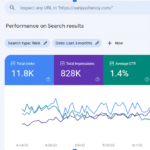
The easiest way to check your CTR is Google Search Console where you can track the performance of your web pages. Login to your Google Search Console.
1. Open the Search Results section in the dashboard.
2. Select Average CTR in the graph displayed.
3. You can also select the Date range for the timeline you want to view the CTR for.
4. Below the chart select the Pages tab and choose the page for which you want the CTR results.
5. Then you can look for specific queries in the Queries tab.
What is the good average CTR by position?
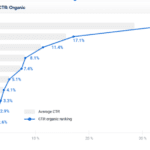
CTR differs by position in the SERP.
How do you determine the CTR in a client’s search ads?
Click-through rate or CTR is the percentage of clicks an ad receives, divided by the number of times the ad is viewed (it’s called impressions):
(clicks / impressions) x 100 = CTR
(10 clicks/ 1000 impressions) x 100 = 1%
What is the main reason for low CTR?
Low CTR could be because of:
– Targeting the wrong audience
– Your content is not relevant
– Ambiguity in keywords –
– Zero-click searches – searches that provide answers in the results without having to click on any of the results.
Is it okay to have a low CTR?
Totally!
Low CTR does not always mean you have failed as much as high CTR does not automatically mean you have succeeded. I can offer freebies and attract multiple clicks but is that my end goal for my business? Maybe not! Such ads are not helping my business. I need to define my business metrics and then check my CTR.
Remember that it is conversions you are looking for more than clicks. CTR is just the means to an end. Low CTR is fine as long as your ads are performing well and you are meeting your business objectives. High conversions with low CTR is better than low conversion with high CTR.
Can you get clicks in spite of zero-click results?
There is no avoiding featured snippets. Either you optimize for featured snippets or find a way to outsmart Google to get clicks anyway.
Follow the best practices I have mentioned in the article and leave the rest to Google God!


